Wherefore art thou, art?
 Reaching for the sky at Cottesloe |
Dance, the most graceful but least verbal of the arts, is something I am learning about fast, having accepted a part-time job with a ballet company.
My moves do not involve gliding around on the floor of practice space. My moves are more prosaic. I help shift tables, as a break from tapping away at a computer keyboard to write letters and material for the company’s website. While waiting for a reply, maybe, I have time to wrestle with questions. Why did I never, as a child, develop an interest in dance, apart from me bopping, jigging and jiving to the Beach Boys and Abba? Why do I, generally speaking, need a verbal component to appreciate the arts, such as drama and opera offer? And, er, what is art? I am not going to live long enough for a definitive answer on this third one. Is colour necessary? Enjoying most exhibits in the Sculpture by the Sea display and competition at Cottesloe Beach earlier this year, I photographed the tall item at the end of the groyne. Against the sky it looked like something in a giant’s adventure playground. |
This week another splash of spectrum made me reach for the camera. This was, however, functional art – an attractive seat in a restaurant at City Beach.
Yet the issue is not simply one of showing hues, shades and blues. In a recent magazine article on “abstract expressionism”, an illustration of a painting by Mark Rothko left me as puzzled as ever. Compared with which, the works of Jackson Pollock seem entirely accessible. In his centenary year, the National Gallery of Australia is showing prominent examples of expressionist paintings. Pollock’s Blue Poles, which caused such a stir in Australia when bought by the Whitlam Government in Canberra almost 40 years ago, is something I have grown to admire. No idea why. But Rothko . . . and Australian Tony Tuckson . . . please Google Tony’s White Over Red on Blue. Enlighten me, please. |
